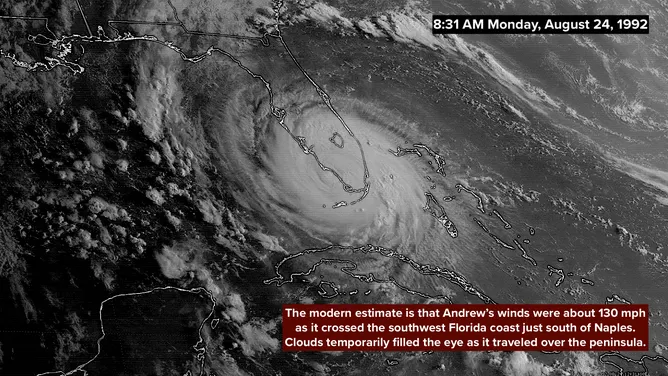Hurricane Andrew: A South Florida Nightmare – August 24, 1992

The morning of August 24, 1992, dawned bright and clear in South Florida, but the calm was a cruel deception. Lurking in the Atlantic, Hurricane Andrew, a Category 5 monster, was on a collision course. By the time the sun set, Andrew would etch its name in history as one of the most destructive hurricanes to ever strike the United States, leaving behind a trail of devastation that would take years to rebuild.
Andrew’s journey of destruction began in the eastern Atlantic as a tropical wave, gradually gaining strength as it moved westward. By August 22nd, it had intensified into a Category 5 hurricane with sustained winds of 175 mph. After pummeling the northern Bahamas, Andrew set its sights on South Florida. Despite weakening slightly to a Category 4, Andrew remained a formidable force, boasting winds of 145 mph as it approached the coast.
Around 5 AM on August 24th, the hurricane’s eyewall slammed into Elliott Key, just south of Miami. The anemometer at the National Hurricane Center in Coral Gables clocked a peak gust of 177 mph before being destroyed by the wind. Homes were ripped apart, boats tossed ashore like toys, and palm trees stripped bare. The storm surge, a wall of water pushed ashore by the hurricane, inundated coastal areas, flooding streets and homes.
The devastation wasn’t confined to the immediate coastline. As Andrew moved inland, its powerful winds tore through Homestead, Florida City, and Kendall, leaving behind scenes reminiscent of a war zone. Homestead Air Force Base, located near the eye of the storm, was virtually destroyed, with aircraft hangars crumpled and fighter jets tossed about like paper airplanes. Mobile home parks were obliterated, shopping centers reduced to rubble, and thousands of homes left uninhabitable. The darkness of the early morning, combined with the howling winds and driving rain, created an atmosphere of pure terror for those trapped in the storm’s path.
Andrew’s destructive power was fueled by a combination of factors. The warm waters of the Atlantic provided ample energy for the storm to intensify. Additionally, a lack of wind shear, which can disrupt a hurricane’s organization, allowed Andrew to maintain its strength. The storm’s compact size, while limiting the geographic scope of its impact, concentrated its destructive winds over a smaller area, resulting in catastrophic damage. The pressure readings recorded in Homestead were some of the lowest ever observed in a hurricane striking the U.S. mainland, indicating the storm’s incredible intensity.
The aftermath of Hurricane Andrew revealed a landscape of unimaginable destruction. Over 125,000 homes were damaged or destroyed, leaving thousands homeless. Millions were left without power, and the economic losses reached an estimated $26 billion, making it the costliest natural disaster in U.S. history at the time. The storm exposed flaws in building codes and emergency preparedness, prompting significant changes in both areas.
The human cost of the disaster was equally staggering. In Florida alone, 44 deaths were directly attributed to the hurricane, with another 15 indirectly caused by the storm. Thousands more were injured, and the psychological scars left by the trauma of the event were deep and long-lasting.
While the physical scars of Hurricane Andrew have faded with time, the memories of its devastating impact remain vivid for those who lived through it. The storm serves as a stark reminder of the destructive power of nature and the importance of respecting and preparing for its fury. The lessons learned from Andrew have led to improved building codes, better emergency response systems, and a heightened awareness of hurricane preparedness, ultimately saving countless lives in subsequent storms.
Adjusted for inflation, the estimated $26 billion in damages translates to a staggering $55.6 billion in today’s dollars, underscoring the immense financial impact of the storm. This figure encompasses a wide range of losses, including:

- Residential and Commercial Property Damage: Andrew obliterated thousands of homes and businesses, leaving behind a landscape of rubble. Rebuilding costs, coupled with lost economic activity, contributed significantly to the overall financial toll.
- Infrastructure Damage: The storm inflicted severe damage on critical infrastructure, including power grids, communication systems, and transportation networks. Repairing and restoring these essential services added to the overall cost.
- Agricultural Losses: The agricultural sector, particularly in South Florida, suffered extensive losses due to crop damage and destruction of farming infrastructure.
- Insurance Payouts: Insurance companies faced massive payouts to cover property damage claims, leading to increased premiums and financial strain within the industry.
Timeline of Hurricane Andrew:

- August 14, 1992: A tropical wave emerges off the coast of Africa, marking the genesis of what would become Hurricane Andrew.
- August 16-22, 1992: The tropical wave strengthens as it tracks westward across the Atlantic, eventually becoming a tropical storm and then rapidly intensifying into a Category 5 hurricane by August 22nd.
- August 23, 1992: Andrew makes landfall in the northern Bahamas as a Category 4 hurricane, causing significant damage.
- August 24, 1992 (Early Morning): Hurricane Andrew makes landfall near Elliott Key, Florida, as a Category 5 hurricane with sustained winds of 165 mph, causing catastrophic damage in South Florida, including Homestead, Florida City, and Kendall.
- August 24-26, 1992: Andrew weakens as it crosses the Gulf of Mexico but regains strength before making a second landfall as a Category 3 hurricane in Louisiana, causing further damage.
- August 26-28, 1992: Andrew weakens into a tropical depression as it moves inland and dissipates over the eastern United States.
